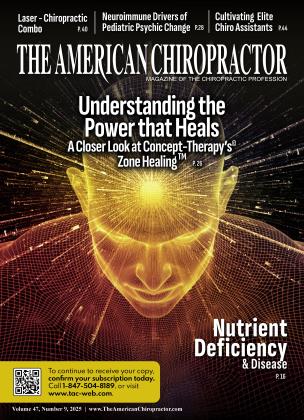Understanding and Identifying the Neuroimmune Drivers of Pediatric Psychiatric Change
September 1 2025 Dr. J. Brandon BrockUnderstanding and Identifying the Neuroimmune Drivers of Pediatric Psychiatric Change
September 1 2025 Dr. J. Brandon Brock
PEDIATRIC ACUTE-ONSET NEUROPSYCHIATRIC SYNDROME (PANS) is a complex, underrecognized condition that can profoundly affect the health and development of children and adolescents. Despite a growing body of research highlighting its immune-mediated origins, many patients are misdiagnosed with autism spectrum disorder (ASD), attention-deficit/hyperactivity disorder (ADHD), obsessive-compulsive disorder (OCD), or pediatric bipolar disorder.
In many instances, PANS is not only mistaken for these conditions but may also present concurrently or exacerbate underlying neurodevelopmental or psychiatric disorders. Furthermore, overlapping features, such as rigidity, sensory issues, and executive dysfunction, can blur the diagnostic lines, especially when PANS symptoms superimpose on preexisting developmental disorders.
What sets PANS apart is its abrupt onset; children who were previously well may suddenly exhibit severe anxiety, compulsive behaviors, irritability, academic regression, or emotional volatility. Often, these symptoms follow infection, immune challenges, or exposure to environmental toxins.
“At its core, PANS is a neuroimmune condition.”
At its core, PANS is a neuroimmune condition. When the immune system is activated by infection or environmental insult, it can misdirect its attack and produce antibodies that cross-react with neuronal antigens, particularly those within the basal ganglia.
This autoimmune process, known as molecular mimicry, disrupts motor pathways, executive function, emotional regulation, and sensorimotor integration.1-2 Infections such as group A streptococcus, Epstein-Banvirus, and mycoplasma pneumoniae are frequently implicated with symptom flares often corresponding to immune activity.3
Beyond infection, environmental contributors play a significant role. Exposure to mold toxins, heavy metals, or chemicals can compromise detoxification pathways and increase oxidative stress, tipping the immune balance toward chronic inflammation.
In genetically susceptible children with MTHFR mutations, poor glutathione recycling, or HLA variants, these exposures are not quickly cleared, allowing immune dysregulation to persist.4-5 This results in a complex layering of infl aimnation, neurological dysfunction, and behavioral symptoms.
Recognizing PANS requires clinicians to step back and consider the broader context. Unlike developmental disorders that develop gradually, PANS presents with an acute change in trajectory. A child may regress academically, lose social engagement, develop restrictive eating patterns, or suddenly exhibit intense fears or tics. This rapid deterioration distinguishes it from the chronic profiles of ASD or primary mood disorders.6
During clinical examination, subtle yet revealing findings may emerge. Neurological soft signs — choreiform movements, motor impersistence, tongue fasciculations, or a positive glabellar reflex — can indicate basal ganglia involvement.7 Qualified functional and integrative practitioners often identify retained primitive reflexes, such as the Moro or asymmetric tonic neck reflex (ATNR), postural imbalances, vestibular dysfunction, or abnormal saccadic eye movements.8-9 These physical signs may correlate with cortical disinhibition, cerebellar dysregulation, or poor hemispheric integration.
From a neurophysiological perspective, the basal ganglia, cerebellum, and prefrontal cortex are key players in PANS. Autoantibodies that target the basal ganglia can impair thalamocortical circuits, disrupting mood, cognition, and movement control.10 Additionally, cerebellar inflammation can degrade proprioceptive input and balance regulation, leading to clumsiness, sensory hypersensitivities, or disorientation.
Functional connectivity between the cerebellum and frontal lobes is crucial for regulating attention, working memory, and affect. When inflammation disrupts these networks, children experience a cascade of dysregulated behavioral, emotional, and physical responses.
“Detoxification should be personalized and considered for patients with identifiable environmental toxicant burdens.”
A comprehensive diagnostic workup for PANS must be broad and focused, capturing infectious, immunologic, environmental, nutritional, and neurophysiological contributors. Infectious panels should include but are not limited to streptococcal markers such as antistreptolysin O (ASO) and anti-DNase B, along with mycoplasma pneumoniae IgG/IgM, Epstein-Barr virus (EBV) titers, human herpesvirus 6 (HHV-6), and Borrelia (Lyme) panels. Where appropriate, screening for Bartonella, babesia, Ehrlichia, and even post-COVID immune shifts may be warranted.11
Autoimmune and inflammatory testing should encompass antinuclear antibody (ANA), rheumatoid factor, thyroid autoantibodies (TPO and thyroglobulin), and inflammatory markers, including ESR, CRP, and ferritin. Advanced immune profiling, such as cytokine panels (IL-6, IL-ip, TNF-a), total immunoglobulins, and IgG subclasses, may help characterize immune dysfunction. The Cunningham Panel offers additional insight into autoimmune neuropsychiatric processes by measuring autoantibodies to dopamine DI and D2 receptors, lysoganglioside-GMl, tubulin, and CaMKII activation, which supports a diagnosis of immune-mediated basal ganglia dysfunction when elevated.
Environmental toxin screening should include urine mycotoxins (e.g., ochratoxin A, gliotoxin, trichothecenes), heavy metal analysis (mercury, lead, arsenic), and volatile organic compound (VOC) panels when exposure is suspected.12,13 Nutritional assessments should not be overlooked and should include vitamin D, B12, folate, zinc, magnesium, ferritin, and methylation markers, such as homocysteine and methylmalonic acid.14 Where indicated, mitochondrial and metabolic markers (e.g., glutathione, organic acids) can also be helpful.
Neuroimaging, though not always necessary, may reveal basal ganglia inflammation on MRI with FLAIR sequences; functional imaging such as SPECT or PET may support perfusion deficits in more complex cases.15 Finally, EEG should be considered when seizure activity or altered mental status is suspected. This multimodal assessment framework enables accurate diagnosis and personalized treatment planning in children with suspected PANS. In many cases, these advanced tools directly lead to actionable treatment decisions, such as initiating immunomodulation, detoxification, or neurorehabilitation.
Effective treatment for PANS is individualized, layered, and interdisciplinary. The primary pillars of intervention include immune modulation, infection control, detoxification, neurorehabilitation, nutritional optimization, and psychosocial support.
Diagnostic findings should guide medical therapy. Antimicrobials, such as penicillin, azithromycin, or doxycycline, are commonly used to target acute or chronic infections. Inflammatory flares may require corticosteroids, NSAIDs, or immunomodulators, such as intravenous immunoglobulin (IVIG) or plasmapheresis, in severe, refractory cases.1
Detoxification should be personalized and considered for patients with identifiable environmental toxicant burdens. Targeted detoxification can reduce neuroinflammation and restore immune balance in children exposed to mold toxins, VOCs, or heavy metals.12
Therapeutic strategies may include binders such as activated charcoal, bentonite clay, zeolite, chlorella, fulvic and humic acids, and modified citrus pectin. 13,17These agents are often paired with antioxidants like glutathione, N-acetylcysteine (NAC), alpha-lipoic acid, and vitamin C to mitigate oxidative stress and support detoxification pathways.18
Adjunctive therapies, including sauna therapy, structured hydration, lymphatic drainage techniques, and gut-repair protocols, are frequently used to facilitate toxin mobilization and excretion.1920 Low-level laser therapy (LEET) has also been shown to enhance mitochondrial and lymphatic function, potentially accelerating detoxification and reducing inflammation.21
Laboratory-guided assessments of methylation status, omega-3 to omega-6 ratios, and EPA to arachidonic acid (AA) balance are crucial to customize nutritional and metabolic interventions.14 22 This list is illustrative rather than exhaustive; all therapeutic options must be tailored to the patient’s pathophysiological profile, genetic vulnerabilities, and treatment tolerance to ensure safety and efficacy.
Functional neurological rehabilitation is essential for restoring brain-body integration. Practitioners trained in this approach employ targeted therapies such as vestibular stimulation, reflex inhibition exercises, gaze stabilization, hemispheric activation protocols, and sensorimotor retraining. These strategies promote neuroplasticity, reestablish cortical regulation, and reduce autonomic dysregulation.8 23
Educational accommodations are essential. Children with PANS may experience executive dysfunction, academic decline, or sensory overload. Schools should implement individualized education plans (lEPs) with flexible expectations, reduced workloads, and access to calm environments. Therapists who are knowledgeable about neuroimmune syndromes can assist with emotional and social regulation.
Family-centered care is essential. PANS often places emotional and logistical strain on families. Parents should receive counseling, structured routines, and tools for behavior management. Understanding the episodic nature of the condition builds resilience and prevents unnecessary psychiatric labeling.
Recognition Tips for Practitioners:
• If psychiatric symptoms appear rapidly after infection, consider PANS.
• Track functional regression — emotional, cognitive, motor — not just symptom labels.
• Subtle neurological findings (reflexes, vestibular deficits) may be your best supportive clinical clues to monitor.
“Schools should implement individualized education plans (lEPs) with flexible expectations, reduced workloads, and access to calm environments.”
PANS is not rare; it is often misunderstood. In many cases, what appears as a psychological disorder may arise from an underlying, potentially treatable, physiological mechanism that can be understood from a mechanistic perspective. Children affected by PANS deserve a multidisciplinary approach guided by providers skilled in neuroimmunology, environmental medicine, and functional neurology — professionals who grasp the complexities of immune, infectious, neurological, and metabolic interactions.
When these cases are addressed with clinical insight, collaborative care, and targeted intervention, we offer these children a genuine opportunity to recover, reintegrate, and thrive. This condition may be silent in mainstream discourse, but it is unmistakably loud in the homes of those affected. It’s time we listened and acted with precision and compassion.

Dr. Brandon Brock, PhD, DNP, DC, APRN, FNP-C, DACNB, is a leading clinician and educator in functional medicine, integrative neurology, and regenerative therapeutics. He practices at Carpathia Wellness Group and serves as an educator for Nutri-West and Erchonia. Dr. Brock specializes in complex neurological and chronic conditions, blending clinical innovation with compassionate, multidisciplinary care. Visit Nutri-West.com.
1. Hornig, M., Briese, T, & Lipkin, W. I. (2016). Autoimmunity and the basal ganglia: New insights from animal models. Trends in Neurosciences, 39(5), 271-283. https://doi.Org/10.1016/j.tins...
2. Vreeland A, Thienemann M, Cunningham M, Muscal E, Pittenger C, Frankovich J. Neuroinflammation in obsessive-compulsive disorder: sydenham chorea, pediatric autoimmune neuropsychiatric disorders associated with streptococcal infections, and pediatric acute onset neuropsychiatric syndrome. Psychiatr Clin North Am. 2023 Mar;46(l):6988. doi: 10.1016/j.psc.2022.11.004. PMID: 36740356.
3. Gagliano A, Carta A, Tanca MG, Sotgiu S. Pediatric acute-onset neuropsychiatric syndrome: current perspectives. Neuropsychiatr Dis Treat. 2023 May 24;19:1221-1250. doi: 10.2147/NDT.S362202. PMID: 37251418; PMCID: PMC10225150.
4. Leuzzi et al., 2020
5. Kharrazian D. Exposure to environmental toxins and autoim-
mune conditions. Integr Med (Encinitas). 2021 Apr;20(2):20-24. PMID: 34377090; PMCID: PMC8325494.
6. Chang K, Frankovich J, Cooperstock M, Cunningham MW, Latimer ME, Murphy TK, Pastemack M, Thienemann M, Williams K, Walter J, Swedo SE; PANS Collaborative Consortium. Clinical evaluation of youth with pediatric acute-onset neuropsychiatric syndrome (PANS): recommendations from the 2013 PANS Consensus Conference. J Child Adolesc Psychopharmacol. 2015 Feb;25(l):3-13. doi: 10.1089/cap.2014.0084. Epub 2014 Oct 17. PMID: 25325534; PMCID: PMC4340805.
7. Zebrack IE, Gao J, Verhey B, Tian L, Stave C, Farhadian B, Ma M, Silverman M, Xie Y, Tran P, Thienemann M, Wilson IE, Frankovich J. Neurological soft signs at presentation in patients with pediatric acute-onset neuropsychiatric syndrome. JAMA Netw Open. 2025 Mar 3;8(3):e250314. doi: 10.1001 /j amanetworkopen.2025.0314. PMID: 40053347; PMCID: PMC11889471.
8. Schneider et al., 2016
9. Rosenhall U, Johansson E, Gillberg C. Oculomotor findings in autistic children. J Larvngol Otol. 1988 May;102(5):435-9. doi: 10.1017/s0022215100105286. PMID: 3397639.
10. Ring HA, Serra-Mestres J. Neuropsychiatry of the basal ganglia. J Neurol Neurosurg Psychiatry. 2002 Jan;72(l):12-21. doi: 10.1136/jnnp.72.1.12. PMID: 11784818; PMCID: PMC1737705.
11. Murphy TK, Storch EA, Lewin AB, Edge PJ, Goodman WK. Clinical factors associated with pediatric autoimmune neuropsychiatric disorders associated with streptococcal infections. J Pediatr. 2012 Feb;160(2):314-9. doi: 10.1016/j.jpeds.201L07.012. Epub 2011 Aug 25. PMID: 21868033; PMCID: PMC3227761.
12. Cabrera-Mendoza, B., Brossard, M., & Zegarra-Valdivia, J. A. (2022). Toxicant exposures and autoimmunity: emerging connections in neuroinflammation. Toxics, 10(11), 653. https://doi.org/10.3390/toxics...
13. Brewer JH, Thrasher JD, Straus DC, Madison RA, Hooper D. Detection of mycotoxins in patients with chronic fatigue syndrome. Toxins (Basel). 2013 Apr ll;5(4):60517. doi: 10.3390/toxins5040605. PMID: 23580077; PMCID: PMC3705282.
14. James SJ, Melnyk S, Jernigan S, Cleves MA, Halsted CH, Wong DH, Cutler P, Bock K, Boris M, Bradstreet JJ, Baker SM, Gaylor DW. Metabolic endophenotype and related genotypes are associated with oxidative stress in children with autism. Am J Med Genet B Neuropsychiatr Genet. 2006 Dec 5;141B(8):94756. ' doi: 10.1002/ajmg.b.30366. PMID: 16917939; PMCID: PMC2610366.
15. Server Alonso A, Sakinis T, Pfeiffer HCV, Sandvig I, Barlinn J, Marthinsen PB. Understanding pediatric neuroimmune disorder conflicts: a neuroradiologic approach in the molecular era. Radiographics. 2020 Sep-Oct;40(5): 1395-1411. doi: 10.1148/ rg.2020200032. Epub 2020 Jul 31. PMID: 32735475.
16. Swedo SE, Frankovich J, Murphy TK. Overview of treatment of pediatric acute-onset neuropsychiatric syndrome. J Child Adolesc Psychopharmacol. 2017 Sep;27(7):562-565. doi: 10.1089/cap.2017.0042. Epub 2017 Jul
19. PMID: 28722464; PMCID: PMC5610386.
17. Crinnion, W. J. (2011). Functional medicine detoxification: A review of the science and principles behind the removal of toxicants. Alternative Medicine Review, 16(2), 84-96.
18. Pizzomo J. Glutathione! Integr Med (Encinitas). 2014 Feb;13(l):8-12. PMID: 26770075; PMCID: PMC4684116.
19. Hannuksela ML, Ellahham S. Benefits and risks of sauna bathing. Am J Med. 2001 Feb l;110(2):118-26. doi: 10.1016/s00029343(00)00671-9. PMID: 11165553.
20. Fasano A. Leaky gut and autoimmune diseases. Clin Rev Allergy Immunol. 2012 Feb;42(l):71-8. doi: 10.1007/sl2016-0118291-x. PMID: 22109896.
21. Chung H, Dai T, Sharma SK, Huang YY, Carroll JD, Hamblin MR. The nuts and bolts of low-level laser (light) therapy. Ann Biomed Eng. 2012 Feb;40(2):516-33. doi: 10.1007/S10439-011-0454-7. Epub 2011 Nov 2. PMID: 22045511; PMCID: PMC3288797.
22. Simopoulos AP. An increase in the omega-6/omega-3 fatty acid ratio increases the risk for obesity. Nutrients. 2016 Mar 2;8(3):128. doi: 10.3390/nu8030128. PMID: 26950145; PMCID: PMC4808858.
23. Melillo R. Leisman G. Neurobehavioral disorders of childhood: an evolutionary perspective. New York; Springer; 2009.
24. Toufexis, M. D., Ramsey, J. M., & Heninger, M. D. (2020). Immunology of neuropsychiatric disorders in children. Child and Adolescent Psychiatric Clinics of North America, 29(1), 1-14. https://doi. org/10.1016/j.chc.2019.08.001
 View Full Issue
View Full Issue






